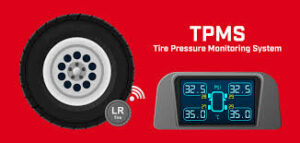Blog
“Signs Your TPMS Might Be Failing and What to Do”
Signs Your TPMS Might Be Failing and What to Do
Your vehicle’s Tire Pressure Monitoring System (TPMS) is a crucial safety feature that alerts you when your tires are underinflated. However, like any other component, TPMS can experience issues over time. Knowing the signs of a failing TPMS and addressing them promptly can save you from unsafe driving conditions and costly repairs.
Here’s how to identify potential TPMS problems and what steps to take if they arise.
What Is TPMS?
Before diving into the signs of failure, it’s essential to understand how TPMS works. There are two main types of TPMS:
- Direct TPMS: Uses sensors inside the tires to measure air pressure directly.
- Indirect TPMS: Relies on the vehicle’s ABS system to estimate tire pressure based on wheel speed and rotation.
Both systems alert drivers when tire pressure drops below a safe threshold, helping maintain vehicle safety and fuel efficiency.
Common Signs Your TPMS Might Be Failing
1. Persistent Warning Light
The most obvious indicator of a TPMS issue is a warning light on your dashboard.
- Blinking Warning Light: A blinking or flashing TPMS light usually signals a problem with the system itself, such as a sensor malfunction or communication error.
- Steady Warning Light: This may indicate low tire pressure, but if the tires are properly inflated and the light persists, the TPMS might be malfunctioning.

2. Inconsistent Tire Pressure Readings
If the TPMS shows incorrect or fluctuating pressure readings despite manual checks confirming proper inflation, the sensors might be faulty.
3. No Alerts Despite Pressure Changes
If one or more tires are significantly underinflated and the TPMS doesn’t trigger a warning, the system may not be working correctly.
4. Unresponsive Sensors
Over time, the sensors in a direct TPMS can fail due to:
- Battery depletion.
- Physical damage from potholes, road debris, or improper handling during tire changes.
5. Frequent Need for Calibration (Indirect TPMS)
If you’re constantly recalibrating your TPMS after minor adjustments, it may indicate a deeper issue with the system’s accuracy or alignment.
Causes of TPMS Failure
Several factors can contribute to TPMS malfunctions:
- Sensor Battery Depletion
In direct TPMS systems, sensors are powered by small batteries that typically last 5–10 years. Once the batteries die, the sensors stop functioning. - Damage to Sensors
Sensors can be damaged during tire changes, by hitting a pothole, or due to corrosion from moisture. - Software Glitches
TPMS systems rely on software to communicate with the vehicle. Updates or bugs can occasionally cause issues. - Wiring or Communication Issues
Damage to wiring or interference with the wireless connection in direct TPMS systems can result in communication failures. - Environmental Factors
Extreme temperatures can temporarily affect TPMS performance, causing false alerts or slow sensor responses.
What to Do If Your TPMS Is Failing
If you suspect your TPMS isn’t working correctly, take the following steps:
1. Check Tire Pressure Manually
Use a tire pressure gauge to confirm the air pressure in each tire matches the manufacturer’s recommendations. This will help you determine whether the issue lies with the tires or the TPMS.
2. Inspect Sensors and Valves
Look for visible damage or corrosion on the tire valves or sensors. Physical issues may require replacement.
3. Reset the TPMS
Sometimes, resetting the system can resolve minor software glitches. Refer to your vehicle’s manual for specific instructions on how to recalibrate or reset the TPMS.
4. Visit a Professional Mechanic
If the problem persists, a mechanic can:
- Diagnose sensor or system failures.
- Replace faulty sensors.
- Update or reprogram the TPMS software.
5. Consider Aftermarket Solutions
If repairs are costly or your vehicle lacks TPMS entirely, aftermarket systems can provide a cost-effective alternative with modern features like smartphone connectivity.

Preventing TPMS Issues
Proactive maintenance can help extend the lifespan of your TPMS and avoid costly repairs:
- Regular Tire Maintenance: Check tire pressure manually at least once a month to ensure accuracy.
- Protect Sensors During Tire Changes: Notify technicians to handle TPMS sensors carefully.
- Replace Sensor Batteries on Schedule: Be aware of your TPMS battery lifespan and replace them proactively.
- Stay Updated on Software: Ensure your vehicle’s TPMS software is up-to-date to avoid glitches.
- Avoid Harsh Conditions: Minimize exposure to extreme temperatures, road salt, and moisture, which can damage sensors.
Why It’s Important to Address TPMS Issues
Ignoring a malfunctioning TPMS can lead to serious consequences:
- Reduced Safety: You may unknowingly drive on underinflated tires, increasing the risk of blowouts or accidents.
- Higher Costs: Driving on poorly inflated tires accelerates wear and reduces fuel efficiency, leading to expensive replacements and repairs.
- Legal Compliance: In many regions, vehicles must have a functioning TPMS to pass inspections.
Conclusion
A functional Tire Pressure Monitoring System (TPMS) is essential for maintaining tire safety, vehicle efficiency, and overall driving confidence. By recognizing the signs of a failing TPMS—such as persistent warning lights, inaccurate readings, or unresponsive sensors—you can take timely action to avoid bigger issues.
For expert advice and solutions for your TPMS or other automotive needs, visit RegalXmuse.com—your trusted source for car maintenance insights.


